Chapter 9 – Risks and Challenges
9.1 Introduction
It is unlikely that you will have to plan for logistics disruptions due to Godzilla as depicted in Figure 9.1. However, disruptions and delays to transportation and storage issues may have a similar impact. Logistics in a supply chain face many risks and challenges and Just when you think it is safe to ship your goods, unexpected situations or events can disrupt those plans. It is crucial to identify potential risks in a supply chain and create plans to mitigate the impact of these risks. Preparing in advance to identify risks and challenges to moving and storing products is part of logistics management in a supply chain. In this chapter, we identify current risks and challenges, explore potential risks and future challenges, and develop risk management strategies for assessing major risks and challenges in a supply chain.
Figure 9.1
Godzilla Playing with Trains in Godzilla 1985

Note. From Simpson, 2019. CC BY-NC 2.0.
9.2 Learning Objectives
- Identify risks and current challenges that supply chain logistics face.
- Explore potential risks and future challenges that supply chains logistics might face.
- Develop risk management strategies to assess major risks and challenges for logistics in a supply chain.
9.3 Pre-Assessment
9.4 Current Challenges in a Supply Chain
Risks in a supply chain can range from road infrastructure, climate change, theft, damage to property, environmental damage, world events, poor inventory management, and delays in transportation to name a few. How often are stolen items never recovered, unlike this example in St. Thomas Ontario where a rash of trailer thefts carrying items like Steel was recovered totalling $1.5 million (Juha, 2021). While insurance coverage deals with the costs of issues after an incident has happened, it doesn’t deal with the challenges of the lack of materials or products needed at the moment. It is better to plan to avoid risk as much as possible and be prepared to dynamically manage situations as they unfold to minimize the damage caused. The first step in preparing to mitigate risks is to identify potential risks and challenges before they happen.
Supply chains and their logistics networks rely on safety stock (extra stock kept at locations in the logistics network) to compensate for interruptions in product flow. There are competing interests for determining the best amount of inventory at the right places in the supply chain. For example:
- Company financial performance targets usually seek to minimize inventory, mainly due to costs associated with maintaining safety stock.
- Operations staff want to ensure that they have sufficient materials available to keep their production lines running smoothly.
- Marketing and sales staff want to have lots of inventory on the shelves to ensure no missed sales.
- Customers want to pay a reasonable price for the products.
- The globalization of the economy (supply chains and logistics networks that extend around the globe) is fueled by a race to find lower costs, new technologies, people, and resources.
- If you do not include the total system cost that accounts for risk, your decision to move products to a country with cheap labour and alluring cheap per piece costs could be disastrous.
- Just-in-time (JIT) means that just enough product arrives and is available for use just when it is needed as opposed to having lots of inventory available.
- Lean is low waste manufacturing with a focus on continuous improvement and productive use of resources.
- Lean Methods are failing today because of the extensive length of supply chains and the large amounts of inventory needed to support the very long and fragile supply lines established to support them in the global economy.
- Re-shoring, near-shoring and local or regional manufacturing blocks must be reconsidered to mitigate the unhealthy juxtaposition that minimum inventory thinking and our extensive, lengthy, and bloated supply chains present.
- For example, planning for risk in supply chains was inadequate for the disruption caused by the COVID-19 pandemic.
Further Reading: The Impact of COVID-19 on Logistics
The following excerpt from an article titled “The Impact of COVID-19 on Logistics” published by the International Finance Corporation discusses how logistics have been affected by the pandemic and how economies in the world have been and will be affected by the massive disruptions that have occurred:
“The pandemic spread to the rest of the world, leading to lockdowns and border closures that restricted the movement of goods. Additional protocols (such as social distancing at warehouses) introduced to ensure the safety of workers contributed to bottlenecks for freight. For example, in the European Union, trucks formed 37-mile-long lines on the A4 highway after Poland closed its border with Germany in mid-March. In India, the lockdown created a shortage of truck drivers, which resulted in over 50,000 containers piling up in the ports of Chennai, Kamajarar, and Kattupalli.” (International Finance Corporation, 2020, p. 2)
9.5 Current and Future Types of Risks in a Supply Chain
Infrastructure
Infrastructure refers to the road, rail, and water transportation used in the supply chain. This includes docks, harbours, bridges, shipping docks, and the systems used to design, build, and manage them. These transportation networks are significantly developed in some areas and very rugged and underdeveloped in other areas. Logistics decisions must consider the quality and reliability of the transportation infrastructure where the materials and products will travel and be delivered to.
Figure 9.2 shows a truck that crashed into a bridge that was too low for it to pass under. Consider these questions when preparing to mitigate risks in the future. What was the cause? Who planned this route? Was there a mechanical failure? Was the diver trained? What actions could be put into place to prevent this from happening again?
Figure 9.2
Trucker Memes
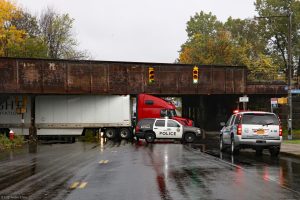
Note. From Swire, 2017. CC BY-NC 2.0.
Environmental
Climate Change
Climate change has many impacts on supply chain logistics. More severe and different types of storms, heatwaves, economic instability, and population migration are just a few examples of impacts resulting from climate change. Extreme flooding in British Columbia in November 2021 after a summer of wildfires is thought to be the result of slow responses to climate change which led to gas rationing as pipelines between Alberta and British Columbia were impacted (Smart, 2021)
Figure 9.3 shows a marina with docks that should be floating but now sit on dry land. Droughts have lowered the water level in the lake. There is not enough water for the boats to dock and the marina to function correctly.
Figure 9.3
A Picture Demonstrating Drought Conditions in California at Lake Oroville
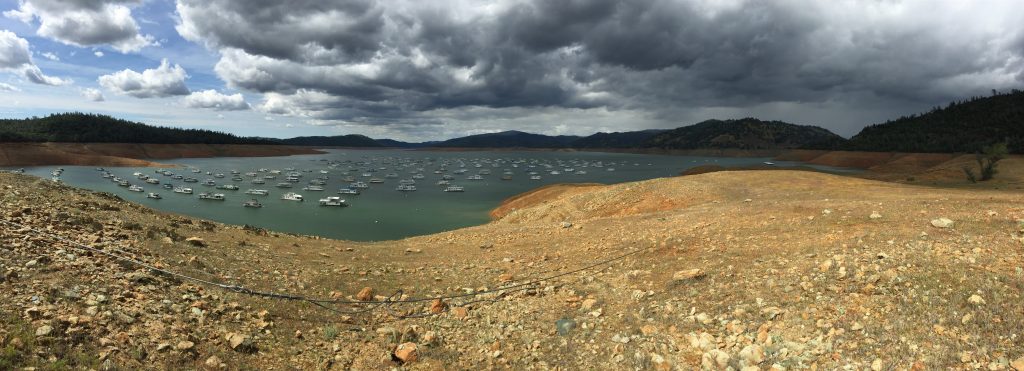
Note. From ray_explores, 2015. CC BY 2.0.
Further Reading: Climate Change Adaptation
Snow and Ice
Snowstorms and blizzards can have a widespread effect on logistics. As Boudette and Eavies (2021) describe a significant winter storm that swept across much of the USA, “[p]ower outages, natural gas shortages and icy conditions made it hard for automakers, retailers and delivery carriers to operate across much of the South and Midwest. The winter storm […] severely disrupted businesses including large car factories, retail chains and the delivery services that people are deeply reliant on for basic necessities.” In Texas, the electrical grid was knocked out. FedEx noted disruptions because of travel hazards caused by the weather (paras. 1, 4, 13). These are just some of the impacts snow and ice can have. Can you think of any related risks you might need to consider if shipping items up to northern Canada?
Figure 9.5
Truck Stuck in the Snow
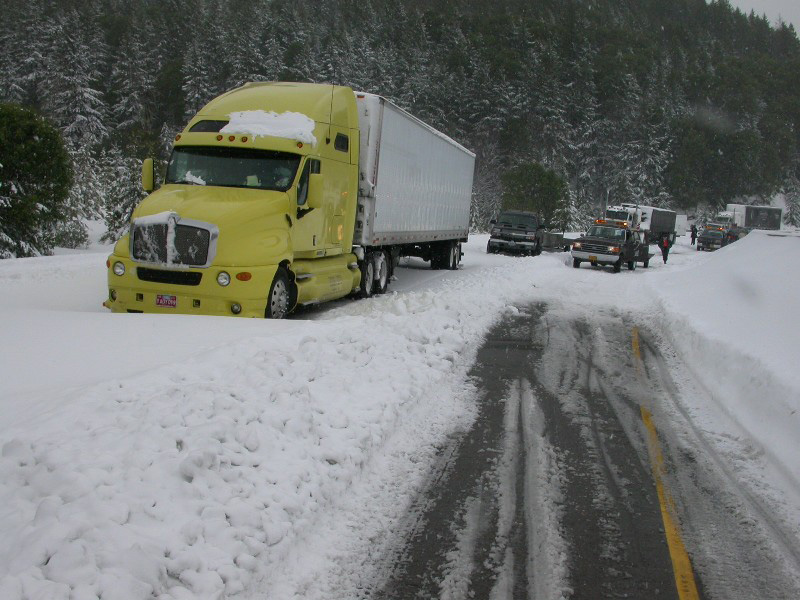
Note. From Oregon Department of Transportation, 2004. CC BY 2.0.
Fire
Wildfires can cause disruptions in supply chains. Routes may get cut off, warehouses might not be accessible or entirely destroyed. This will result in changes to transportation routes and where inventory is stored. Kaplan (2021) describes the impact that the wildfires in California have had on the logistics network: “[w]ith wildfire risks, some companies are considering moving warehousing operations or sourcing from vendors outside of potential fire danger areas” (para. 12).
Figure 9.6
Roads and Wildfires
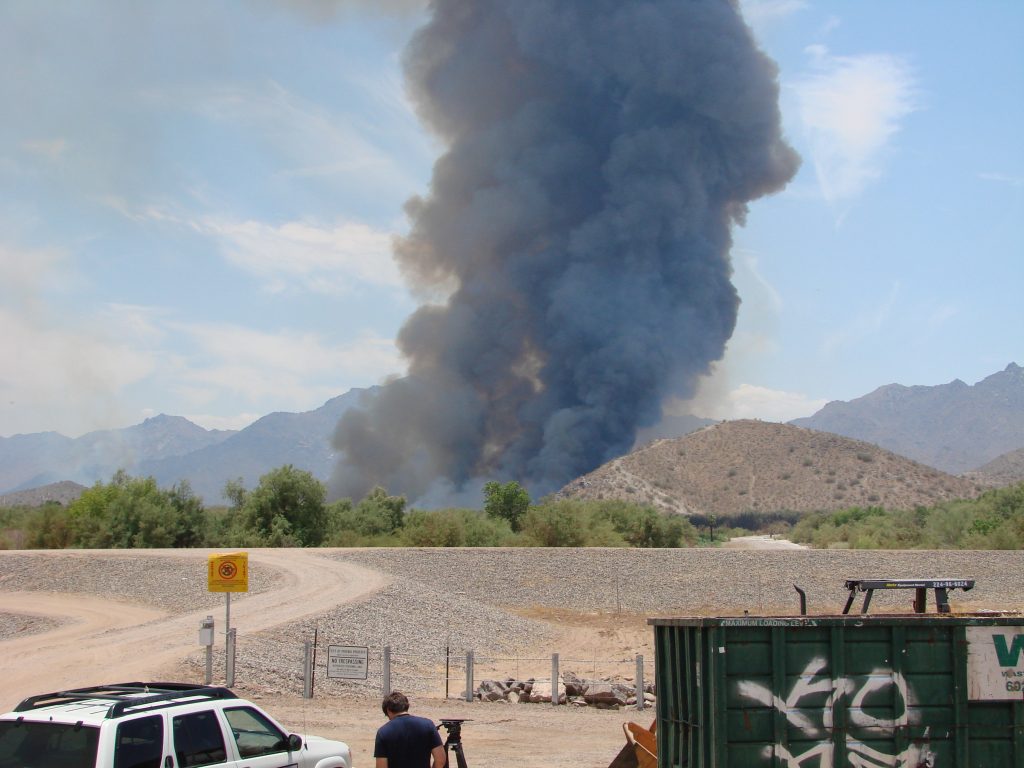 Note. From Spencer, 2008. CC BY-NC 2.0.
Note. From Spencer, 2008. CC BY-NC 2.0.
Major Incidents
Shipwrecks and Oil Spills
The Exxon Valdez accident in 1989 led to a massive oil spill that severely damaged the environment and 1100 miles of coastline (History.com, 2022) This accident impacted the shipping industry, and oil movements globally. New and more expensive ships had to be designed and built or existing ships modified. Insurance costs for transporting oil increased significantly. This added to the final cost. There have been many incidents of oil spills from ships and oil platforms, oil trains, and pipelines, all impacting the environment and the logistics network. New laws, regulations, safety measures and procedures have resulted in safer transportation. This often also increases the cost of logistics. When the total system cost, including the dramatic and long-term impact on the environment, are considered, there are huge risks and costs involved with the shipping and moving dangerous goods and fossil fuels as we do now.
Figure 9.4
Exxon Valdez Oil Spill Disaster
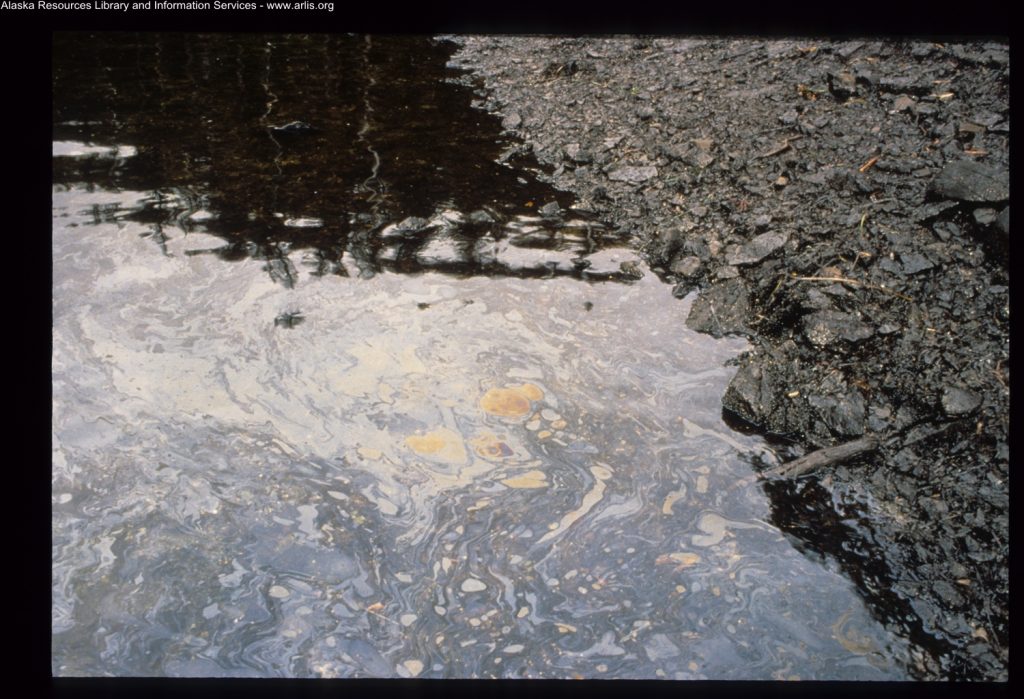 Note. From ARLIS Reference, 2010. CC BY-SA 2.0.
Note. From ARLIS Reference, 2010. CC BY-SA 2.0.
Further Reading: Historic Oil Spills
Learn more about oil spills in Rafferty’s article describing nine of the most significant oil spills in recent history.
Global Pandemics
The COVID-19 pandemic has had a significant impact on logistics both locally and globally. Public health rules and restrictions, people getting sick, closed facilities, health care challenges, and capacity restrictions are some reasons for inventory shortages and delays in logistics networks. These events force supply chain and logistics staff to re-think their entire operation and infrastructure for logistics and facility locations.
Further Reading: Backlogs and Delays at California’s Ports
Due to labour shortages, reduced operations at factories overseas due to COVID-19, and increased online ordering, there are delays at California’s shipping ports (CNN, n.d.).
Major Economic Events
Sudden drops in orders, lack of money to fund operations, and failed suppliers caused considerable disruptions in supply chains. For example, one of the lessons learned from the market collapse of 2008 has been to have greater visibility to the financial health of all business partners, and a much faster and more accurate picture of where inventory is throughout the supply chain. Another lesson learned was the increased knowledge and management of cash flow and not just focusing on revenues and expenses (Mefford, 2009, pp. 9-10).
Political Activity, Terrorism and Wars
Political and government activity such as the Second World War (global event) and unstable security and humanitarian issues in regions create huge impacts on supply chains and logistics. Shipments can suddenly be stopped. Ships, vehicles and cargo may be seized, held, taken or redirected. People may be re-directed or reassigned to other tasks. Governments and authorities may be required to stop or alter logistics plans to meet the needs of an urgent crisis. Logistics people and systems need to respond to this by reprioritizing and communicating the changes throughout the supply chain. This ultimately leads to extended shipping times and increased costs to manage the uncertainty that these disruptions caused. You might need to suddenly find new sources or acquire extra inventory to account for supply disruptions.
Further Reading: Supply Chain Response To Global Terrorism: A Situation Scan
This paper examines how supply chains have responded to terrorism concerns sparked by the events of September 11, 2001. They investigate three factors: how the concern is defined, how the supply chain can be protected, and how supply chains can build resiliency (Sheffi, Rice, Fleck, & Caniato, 2003).
Energy Supply Shortages
Energy used by supply chains comes in the form of electricity and heat generated from water flow, fossils fuels, renewable energy, and other sources. This energy is used to provide power for industries and logistics networks in our supply chains. The security of this supply is fragile in places and has a significant effect on supply chains.
Further Reading: Energy Shortages in China
“China is grappling with a power crunch that threatens to curb economic growth and worsen product shortages that have roiled global supply chains in recent months. Surging coal and gas prices, as well as rising demand for electricity amid a boom in manufacturing and exports, have led to severe power shortages across China, with more than half of all provinces reporting problems. The shortages have resulted in rolling blackouts in some areas, and factories have been forced to close or suspend operations during certain hours to conserve power.” (Griffiths, 2021, paras. 1-3).
9.6 Accidents
Accidents in Shipping Routes
A famous example of an accident in a major shipping route is the 2021 Suez Canal blockage. In March 2021, Evergreen Marine’s large container ship, the Ever Given, ran aground due to high side winds. This 400-metre long ship blocked the canal for six days. The impact was felt around the globe, and the projected costs were astronomical. Russon (2021) stated that “… the blockage could cost global trade between $6bn to $10bn a week and reduce annual trade growth by 0.2 to 0.4 percentage points” (para. 21). The 6-day shut down and two to three weeks to clear the backlog was exacerbated by the impact on logistics caused by the COVID-19 pandemic.
Figure 9.8
Suez Canal Blockage
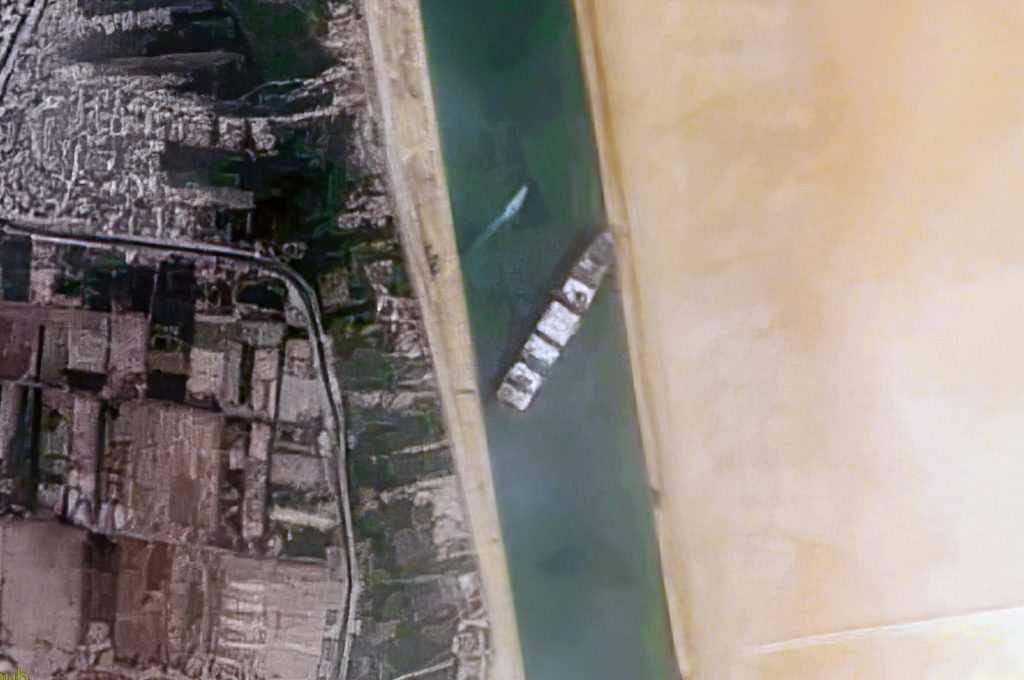 Note. From Markuse, 2021. CC BY 2.0.
Note. From Markuse, 2021. CC BY 2.0.
This image shows an alternate route around Africa instead of going through the Suez Canal which would have added approximately nine days to the ship’s journey (Russon, 2021).
Worker Accidents
Forklifts are a common machine used in warehouses to move materials and products and they pose potential risks to the supply chain due to injury to workers and damage to equipment. In February 2010, the Ministry of Labour conducted many workplace visits to determine the types of hazards connected to operating lifting devices that included forklifts (Ministry of Labour, Training and Skills Development, 2010). Forklift inspection and training became a priority after a report in the mid-1990s identified that 143 people were involved in power-lift incidents resulting in 136 critical injuries and 18 deaths in workplaces in Ontario (Ministry of Labour, Training and Skills Development, 1999). While there have been increased training and safety measurements put in place since then, forklift incidents remain a safety priority and can disrupt the flow of the supply chain. For example, in 2017 a temporary worker was injured when they stood on the forklift forks and the company was fined as neither the operator nor the injured worker had completed the required safety and forklift operating training (Canadian Manufacturing.com, 2017).
9.7 Risk Management Strategies for Assessing and Mitigating Risks and Challenges in a Supply Chain
Consider the following steps when planning for the mitigation of risks and challenges to the supply chain:
- The total cost of your system or process.
- Can it sustainably and reliably continue operations if faced with an unexpected disruption?
- How resilient is your system to changes and disruptions?
- Identify risks and potential risks
- Weight the impact of the identified risks
- Plan for mitigation of the impacts
- Continually learn from how the execution of planned activities during accidents or bad events affected the supply chain’s performance
- Work the lessons learned back into your planning to reduce the impact during the next bad event
9.7 Post Assessment (Check Your Understanding)
9.8 Summary
This chapter on risk just scratches the surface of the subject. Those working in logistics and supply chains must continually identify risks and challenges and assess their impacts on the supply chain. In this chapter, we have identified risks and current challenges, explored potential risks and future challenges, and discussed risk management strategies to better understand major risks and challenges in a supply chain.
9.9 Chapter References
ARLIS Reference. (2010). Exxon Valdez Oil Spill. [Photograph]. Flickr. https://www.flickr.com/photos/arlis-reference/4877037643. Licensed for reuse under CC BY-SA 2.0.
CNN. (n.d.). ‘More ships than parking spots’: What a stuck supply chain looks like [Video]. CNN New Day. https://www.cnn.com/videos/business/2021/10/06/shipping-backup-supply-line-california-ports-lah-newday-vpx.cnn
Eavies, P., & Boudette, N. E. (2021, February 17). Winter storm disrupts wide swath of American business. The New York Times, B1. https://www.nytimes.com/2021/02/16/business/winter-storm-business-disruptions.htm
Griffiths, J. (2021, September 30). Energy crisis, rolling blackouts in China could disrupt global supply chain. The Globe and Mail. https://www.theglobeandmail.com/world/article-energy-crisis-rolling-blackouts-in-china-could-disrupt-global-supply/
History.com Editors. (2021, March 23). Exxon Valdez oil spill. History. https://www.history.com/topics/1980s/exxon-valdez-oil-spill
International Finance Corporation. (2020, June). The impact of COVID-19 on logistics [PDF File]. International Finance Corporation World Bank Group. https://www.ifc.org/wps/wcm/connect/2d6ec419-41df-46c9-8b7b-96384cd36ab3/IFC-Covid19-Logistics-final_web.pdf?MOD=AJPERES&CVID=naqOED5
Juha, J. (2021, February 23) High-value truck hijackings expose Canada’s major freight thefts. Windsor Star. https://windsorstar.com/news/local-news/high-value-truck-hijackings-expose-canadas-major-freight-thefts
Kaplan, D.A. (2021, June 1). More frequent, severe wildfires threaten California’s growing logistics network. Supply Chain Dive. https://www.supplychaindive.com/news/weather-climate-california-wildfire-logistics/600620/
Markuse. (2021). Container Ship ‘Ever Given’ stuck in the Suez Canal, Egypt. [Photograph]. Wikimedia Commons. https://commons.wikimedia.org/wiki/File:Container_Ship_%27Ever_Given%27_stuck_in_the_Suez_Canal,_Egypt_-_March_24th,_2021_cropped.jpg. Licensed for reuse under CC BY 2.0.
Mefford, R.N. (2009). The financial crisis and global supply chains. AIB Insights, 9(3), pp. 8-11. https://repository.usfca.edu/cgi/viewcontent.cgi?article=1010&context=fe
Ministry of Labour, Training and Skills Development. (2009, June). Introduction: Guidelines for safe operation of powered lift trucks. Government of Ontario. https://www.labour.gov.on.ca/english/hs/pubs/lifttrucks/gl_lift_1.php
Ministry of Labour, Traning and Skills Development, (2011, January). Forklift and lifting devices safety in industrial workplaces. Government of Ontario. https://www.labour.gov.on.ca/english/hs/sawo/pubs/fs_forklift.php.
Oregon Department of Transportation. (2004, November 1). Truck stuck in the snow [Photograph]. Flickr. https://www.flickr.com/photos/oregondot/2929723050. Licensed for reuse under CC BY 2.0.
Rafferty, J. P. (n.d.). 9 of the Biggest Oil Spills in History. Encyclopedia Britannica. https://www.britannica.com/list/9-of-the-biggest-oil-spills-in-history
Ray_explores [username]. (2015, April 25). A picture demonstrating drought conditions in California at Lake Oroville [Photograph]. Wikimedia Commons. https://commons.wikimedia.org/wiki/File:California_Lake_Oroville_Drought.jpg. Licensed for reuse under CC BY 2.0.
Russon, M. (2021, March 29). The cost of the Suez Canal blockage. BBC News. https://www.bbc.com/news/business-56559073?piano-modal
Sheffi, Y., Rice, J.B., Fleck, J.M., & Caniato, F. (2003, June 1). Supply chain response to global terrorism: A situational scan. Massachusetts Institute of Technology. https://www.google.com/url?sa=t&rct=j&q=&esrc=s&source=web&cd=&cad=rja&uact=8&ved=2ahUKEwiKu9je4az0AhWIB50JHf6uDrUQFnoECAoQAQ&url=http%3A%2F%2Fweb.mit.edu%2Fscresponse%2Frepository%2Feuroma_paper_041603.doc&usg=AOvVaw0lftGJpKSuTUS9xSuzH5Px
Simpson. (2019). Godzilla playing with trains in Godzilla 1985. [Photograph]. Flickr. https://www.flickr.com/photos/gameraboy/46934809965. Licensed for reuse under CC BY-NC 2.0.
Smart, A. (2021, December 2). Floods, heat in B.C. in line with climate change: meteorologist. Occupational Health and Safety. https://www.ohscanada.com/features/floods-heat-in-b-c-in-line-with-climate-change-meteorologist/
Spencer. (2008). Wildfire. [Photograph]. Flickr. https://www.flickr.com/photos/vek/2614279756/in/photolist-4Z1ShU-4Z1ShG-vDUxN-2GcGSd-2mhArt8-2m8KwAv-5fWJs-2jZbfJT-58oCv7-KahwW-2GcGqq-2hoHxeR-XR8x2w-8irsUR-AiwDPN-6awfMT-amsBzR-XdPRYK-gygbp-gyfGt-2mtKkGY-6UdzWX-gygij-YayVa7-LGsYy-gyfwX-LGAZz-Yc7aPL-gyfTz-LGASp-XR8vnj-j7QuA-o6B8YF-a8hTFq-bob3u-8CpsUe-ehucBv-XdPWog-owRT1d-4SgRgi-gvT27-XdPTuR-gvSV4-XtSc5P-4QRLW5-82mmYh-2jJgx7k-uFhv9K-2iPC3js-2kmJsos. Licensed for reuse under CC BY-NC 2.0.
Swire. (2017). Truck crash at Howard Street and Fillmore Avenue. [Photograph]. Flickr. https://www.flickr.com/photos/18378305@N00/41170543841. Licensed for reuse under CC BY-NC 2.0.

